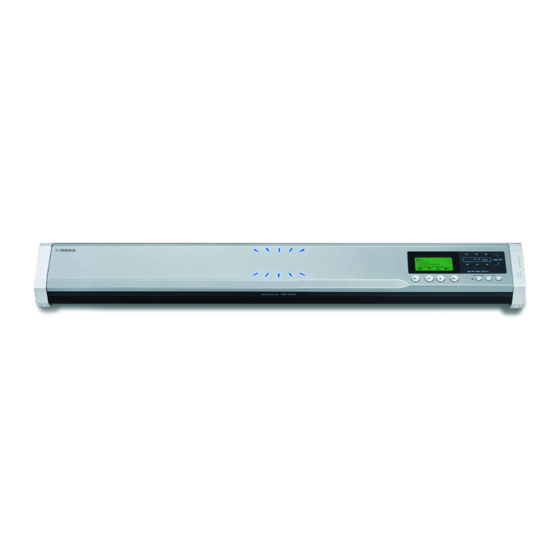Advertisement
Quick Links
Download this manual
See also:
Owner's Manual
Additional information
Due to the upgrading of the firmware, the following functions are added or changed after the printing of the supplied owner's manual.
Interlocked Connection of
Projectphone Systems (Page 30)
The external input/output setting menu is changed and you can
connect multiple Projectphone systems to this unit for the
conference in a large room or with a large number of persons
(interlocked connection of Projectphone systems). The choices
are added to the "External I/O" menu for this change.
■ Connection
Using stereo mini-plug cables, connect the AUDIO OUT terminal
of each Projectphone system to the AUDIO IN terminal of
another Projectphone system. The following illustration shows an
example of an interlocked connection of three Projectphone
systems including this system.
Internet, corporate LAN, etc.
AUDIO OUT
AUDIO IN
AUDIO OUT
AUDIO IN
■ Configuring the external input/output
setting
•
None (Default): Disable external input/output.
•
Audio: Select this setting when connecting external audio
equipment to this unit. This setting is indicated on the initial
display.
•
Connection (mstr): Select this setting for the PJP-100H to be
used as the Master unit. This setting is indicated on the initial
display.
•
Connection (slv): Select this setting for the PJP-100H to be
used as the Slave unit. This setting is indicated on the initial
display.
Using the keys on this unit
In the initial display, select "Menu" → "Settings" → "Sound
Settings" → "External I/O".
Master Unit
1
2
3
4
5
6
7
8
9
0
MIC MUTE
VOL
AUDIO IN
Slave Unit
1
2
3
4
5
6
7
8
9
0
MIC MUTE
VOL
AUDIO OUT
1
2
3
4
5
6
7
8
9
0
MIC MUTE
VOL
Slave Unit
Using the Web menu
In the Web menu, select "External Input/Output".
y
• In an interlocked connection of the Projectphone systems, allow
distance of at least 2 meters between them.
• Set the "Room Size" to "Small" for an interlocked connection.
• When connecting three Projectphone systems (Master, Slave 1
and Slave 2) in an interlocked connection, first connect the
AUDIO OUT terminal of the Master unit to the AUDIO IN
terminal of the Slave 1 unit. And then, connect the AUDIO
OUT terminal of the Slave 1 unit to the AUDIO IN terminal of
the Slave 2 unit. Finally, connect the AUDIO OUT terminal of
the Slave 2 unit to the AUDIO IN terminal of the Master unit.
• If echo or howling is produced, install the Projectphone systems
at larger distances or decrease their volumes.
• To avoid the echo or howling, set the volume level setting of
each Project Phone system to the same level.
Microphone indicators during
muting (Pages 4 and 20)
The microphone indicators (blue LEDs) flash during muting.
Controlling the system using the
remote operation function
(Page 31)
1
2
3
4
5
6
7
8
9
0
MIC MUTE
VOL
Use this feature to control the ProjectPhone when it is used in
conjunction with PJP-MC24. Set "Remote Control" to "Enable"
to activate this feature.
Using the keys on this unit
In the initial display, select "Menu" → "Settings" → "General
Settings" → "Remote Control".
Time Zone (Page 37)
Set the time zone of the region in which the system is used. The
time zone should be set in ±1-hour steps with respect to the UTC
(Coordinated Universal Time).
■ Setting the time zone
Using the Web menu
In the Web menu, select "Time".
Codec compatibility
(Pages 31 and 53)
With the change in the specifications, this unit comparible with
G.729a codec and does not compatible with G.726-40 or G.726-
24 codec. You can select "G.729" and cannot select "G.726-40"
or "G.726-24" in the "CODEC" menu.
PJP-100H
F.W. 2.06
Advertisement

Summary of Contents for Yamaha PJP-100H
-
Page 1: Additional Information
■ Setting the time zone display. Using the Web menu • Connection (mstr): Select this setting for the PJP-100H to be used as the Master unit. This setting is indicated on the initial In the Web menu, select “Time”. display. -
Page 2: Adjust The Volume (Page 28)
Adjust the volume (Page 28) Selecting language (Page 31) “Volume Fine Adj” menu is added to “Sound Settings”. The You can select the language for the display messages. audio input volume from the microphones and the audio input/ ■ Selecting the menu language output volumes from/at the AUDIO IN/OUT terminals can be (Language) adjusted. -
Page 3: Qos Compatibility
QoS compatibility The configuration saving and loading features With the change in the specifications, a QoS (Quality of Service) setting has been added. It is possible to specify the ToS (Type of Due to changes in specifications, the configuration saving and Service) or CoS (Class of Service) priority. -
Page 4: Setting The Password
■ Deleting the password The configuration protection Using the keys on this unit feature (page 32) In the initial display, select “Menu” → “Settings” → “General Settings” → Due to changes in specifications, you can now protect “Password” → “Delete Password”. configurations with a password, not only by using the Web menu but also by using the control keys of this unit. - Page 5 Zone function in “Microphone Mode” (page 28) Within 2 m In “Microphone Mode”, the zone function has been improved and the audio pick up area has been broadened. The zone function can MUTE be selected between “Zone (near)” and “Zone (far)”. ■...
- Page 6 To specify the area to which this feature is available, use the numeric keys in the “Microphone Mode” menu. The area shown in the next figure is enabled or disabled according to the pressed keys. Within 2 m MUTE Within 2 m All microphone indicators (blue LED) from the direction which audio can be picked up light up.















